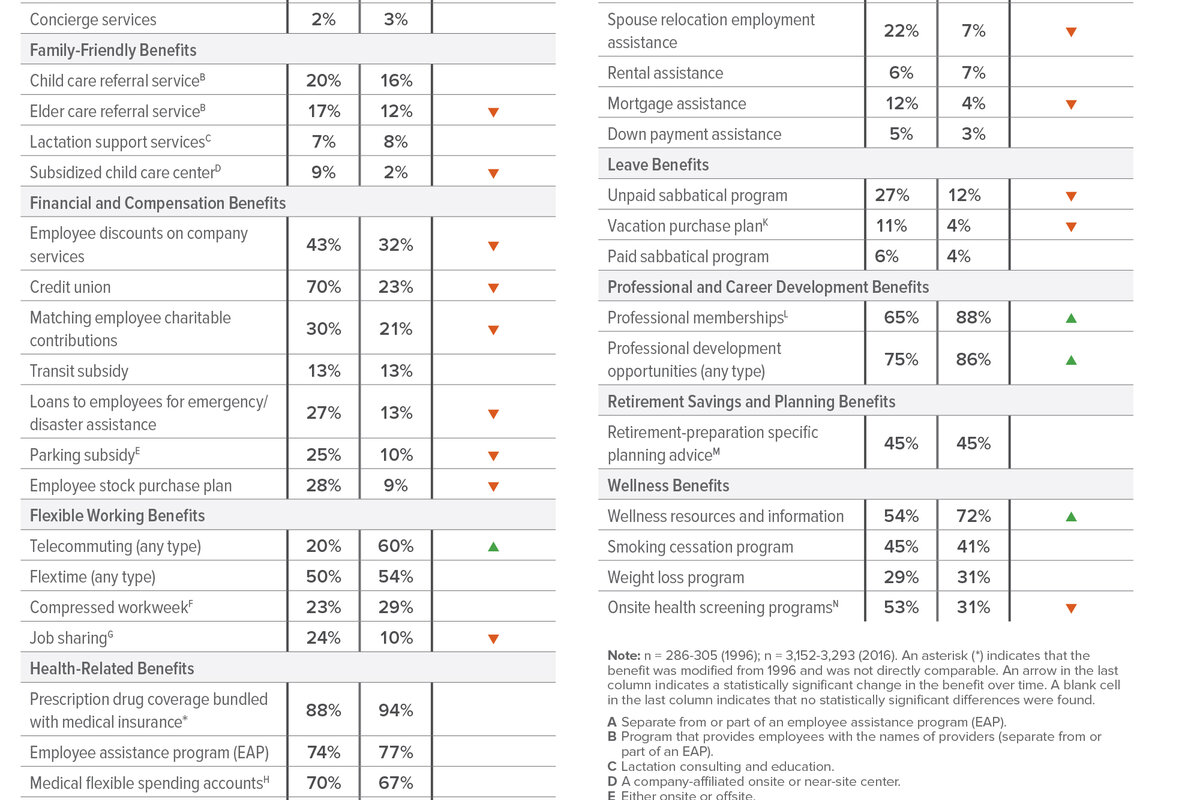Employees today get more work benefits, but there's a catch
Loading...
The benefits American employers offer to their workers are becoming more numerous, and more diverse. According to a report released Monday by the Society for Human Resource Management (SHRM), there were 60 known work-related benefits available to US employees in 1996, including health care coverage, retirement savings, and commuting subsidies. In 2016, that figure has ballooned to 344.
That doesn't mean all employee benefits are more widely available, though some are. For example, 75 percent of businesses offered professional development opportunities in 1996; today, 86 percent of companies do. Additionally, telecommuting (20 percent of companies in 1996 vs. 60 percent in 2016), and legal help for personal matters (13 percent vs. 25 percent) have grown in popularity, according to the report.
At the same time, other benefits are dwindling. Twenty-eight percent of firms offered employee stock purchase plans in 1996; today, it's 9 percent. Parking subsidies (25 percent in 1996 vs. 10 percent in 2016) and subsidized child care (9 percent vs. 2 percent), have also waned over the past two decades, according to the report.
The growing number of benefits appears to reflect a trend among employers of investing more in perks than in wages, according to Andrew Chamberlain, chief economist for Glassdoor, a job-search and company-reviews site.
"Wage growth has been notoriously slow in recent years, hovering around 2 percent compared to the 3-4 percent annual growth of normal times," Dr. Chamberlain writes in a 2015 blog post.
At the same time, he points out that benefits today make up a larger share of the typical employee's compensation package. Perks made up 29 percent of total compensation in 2004, according to a recent US Bureau of Labor Statistics report. By 2015, their share had risen to 31.5 percent -- a 2.5 percent bump.
“That’s a small percentage shift,” Chamberlain writes. “But with roughly $9.5 trillion dollars per year in total US compensation, that’s a shift of nearly $240 billion from wages to benefits – the equivalent of $750 for every man, woman and child in the US.”
Besides shifting more money to benefits, employers also are getting more creative with the types of perks they offer to meet the needs of their changing workforce, says SHRM's head of surveys Evren Esen.
“Organizations will use benefits in a way that is reflective of what their workforce wants and what they value,” Ms. Esen told The Christian Science Monitor in an interview.
The Millennial generation, or those aged 18-34, now comprises the largest share of the American workforce. According to Glassdoor, that cohort values benefits over pay.
But even though quirky benefits such as Facebook’s and Apple’s egg-freezing offering for women, and Pricewaterhouse Coopers and Fidelity school-loan repayment offerings grab national attention and envy, fewer than 5 percent of small businesses offer these perks, according to Esen.
That's likely because for most workers, they aren't a high priority. What today’s workers value most is the same benefits that older generations of workers sought: health care, a retirement savings account, paid time off, and bonuses.
“Interestingly, many headline-catching benefits such as pet-friendly workplaces, reduced and flexible hours, and gym memberships rank near the bottom of this list in terms of correlation with employee satisfaction,” wrote Chamberlain and Glassdoor’s data scientist Gloria Tian in a June 2 research report. The two analyzed a sample of more than 470,000 anonymous benefits reviews on Glassdoor posted between June 18, 2014 and September 20, 2015. The sample, say the researchers, represents 1,226 US companies in all sectors, ranging in size from from 50 employees to more than 10,000.
“Even the much-discussed benefit of free lunch and snacks ranked 16th out of 54 benefits, well behind more prosaic and traditional benefits like retirement plans,” the authors wrote. Maternity and paternity leave also came in at the bottom of the desirability list.
In addition to being high priorities among employees, benefits like healthcare, retirement savings, and paid time off are among the most consistently offered. According to SHRM's report, the number of businesses offering these more traditional benefits has remained largely unchanged over 20 years.
The Society for Human Resource Management also found that over the past five years, firms have begun offering a wider array of financial bonuses. In 2012, for example, 38 percent of companies offered incentives for referring new employees; in 2016, it was 45 percent. More companies also offer financial awards for performance (38 percent in 2012 vs. 43 percent in 2016), sign-on bonuses for both executives (23 percent vs. 31 percent) and non-executives (15 vs. 23), and retention bonuses for executives (13 percent vs. 16 percent) and non-executives (10 percent vs. 14 percent).
To compile its figures, SHRM surveyed a random selection of 3,500 out of its 285,000 American human resources members online early this year. The responders represent small businesses, or those with fewer than 500 employees, across manufacturing, professional services, healthcare, and administrative services industries. The data covers benefits available to employees at all levels of those organizations.
The rise in benefits such as bonuses and professional development opportunities comes as companies are finding recruiting for some highly skilled positions increasingly more challenging, says Esen from SHRM.
“I think it goes hand-in-hand with research indicating that employees don’t necessarily have the skills that companies need to take them to the next level, so companies are investing in training people for those positions,” she tells the Monitor.
SHRM found in a separate survey released Tuesday that more than two-thirds of companies had difficulty filling full-time openings for positions that include nurses, doctors, scientists, mathematicians, electricians, carpenters and mechanics.







